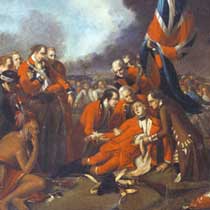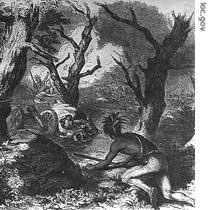VOICE ONE:
This is THE MAKING OF A NATION in VOA Special English. I'm Steve Ember
VOICE TWO:
And I'm Barbara Klein. This week, we tell about the conflicts among the nations in Europe during the eighteenth century and how they affected North America.
VOICE ONE:
During the eighteenth century, Spain, France and Britain controlled land in North America. Spain controlled Florida. France was powerful in the northern and central areas. Britain controlled the east. All three nations knew they could not exist together peacefully in North America. The situation could only be settled by war.
The powerful European nations already were fighting each other for land and money all over the world. These small wars continued for more than one hundred years. They were called King William's War, Queen Anne's War, King George's War and the French and Indian War.
VOICE TWO:
 |
| Detail from ''The Death of General Wolfe,'' a 1770 painting by Benjamin West. James Wolfe was a British general killed during the 1759 battle in which his troops won a victory over the French at Quebec, Canada. |
The French and Indian War was fought to decide if Britain or France would be the strong power in North America. France and its colonists and Indian allies fought against Britain, its colonists and Indian allies.
The war began with conflicts about land. French explorers had been the first Europeans in the areas around the Great Lakes and the Ohio and Mississippi rivers. France had sent traders and trappers to these territories and had established trading centers there.
Britain claimed the same land. When the king gave land in North America to someone, the land was considered to extend from east coast to west coast, even though no one knew where the west coast was. The land along the east coast had become crowded, and settlers were moving west. White people were destroying the Indians' hunting areas. And Indians became worried that they would lose the use of their land.
(MUSIC)
VOICE ONE:
The Indian tribes may have been able to resist the people moving west if they had been united. But their own conflicts kept the Indian groups apart. When Britain and France started fighting each other, some Indians helped the British. Others helped the French.
The French settlers lived mainly in what was called New France. Today it is part of Canada. Life there was different from life in the British colonies to the south. There was no religious freedom, for example. All settlers in French territories had to be French and belong to the Roman Catholic Church. So, many French people who belonged to Protestant churches settled in the British colonies.
France also did not like the fact that the British paid the Indians high prices for animal furs. France was more interested in the fur trade than in settling the land. The British hurt the French traders' business when they bought fur from the Indians.
VOICE TWO:
One of the French trading forts was built in the area where the city of Pittsburgh, Pennsylvania is today. The French called it Fort Duquesne. The British claimed it was in Virginia and that the land belonged to them. In seventeen fifty-four, the governor of Virginia sent a twenty-one-year-old colonist named George Washington to tell the French to get out. This was the same George Washington who would later become the first President of the United States.
The French refused to leave Fort Duquesne. So Washington and one hundred fifty men tried to force them out. They attacked a group of Frenchmen and killed ten of them. The French and Indian War had begun.
(MUSIC)
VOICE ONE:
 |
| The defeat of General Edward Braddock in Virginia in 1755, in a detail from a work by artist John Andrew |
British troops under the command of General Edward Braddock joined George Washington at Fort Duquesne. The British general expected to fight the way battles were fought in Europe. There, troops lined up on open fields and fired their weapons as they marched toward each other.
The French and Indians did not fight this way. They hid in the woods. They wore clothes that made them difficult to see. They shot at the British from behind trees. The British had more troops than the other side. But the French and Indians won the battle of Fort Duquesne. General Braddock was killed.













